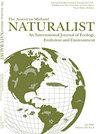Southeastern Pocket Gopher (Geomys pinetis) Tunnels Provide Stable Thermal Refugia
IF 0.6
4区 环境科学与生态学
Q4 Agricultural and Biological Sciences
引用次数: 1
Abstract
Abstract. Animals living underground deal with multiple physiological challenges, such as hypoxia and hypercarbia, but may have reduced thermoregulation demands because of the more stable underground microclimate. Southeastern pocket gophers (Geomys pinetis Rafinesque) occur in the fire-adapted, open-pine forests of the southeastern Atlantic Coastal Plain where prescribed fire is commonly used to manage understory vegetation. They are almost exclusively fossorial, and their tunnels provide ecological services, including shelter, for a suite of commensal vertebrates and invertebrates. To quantify potential thermoregulation benefits of southeastern pocket gopher tunnels, we compared temperatures in active tunnels (n = 31) to aboveground temperatures during winter (December 2018–February 2019), and to aboveground temperatures during prescribed fire events (n = 16) occurring in spring (March–May 2019). During winter, tunnels provided a more stable thermal environment (average range = 6.5 ± 0.8 C; mean ± se) relative to aboveground (average range = 24.8 ± 1.8 C) temperatures. Similarly, mean tunnel temperature range (2.05 ± 0.5 C) was significantly narrower than aboveground temperature range associated with fire events (497.0 ± 101.4 C). Clearly, tunnels provide a stable thermal environment for pocket gophers and commensals that use their tunnel systems.东南口袋Gopher(Geomys-pinetis)隧道提供稳定的热避难所
摘要生活在地下的动物面临着多种生理挑战,如缺氧和高碳酸血症,但由于地下小气候更稳定,它们对体温调节的需求可能会减少。东南口袋地鼠(Geomys pinetis Rafinesque)出现在大西洋东南海岸平原的适应火灾的开放松林中,那里通常使用规定的火灾来管理林下植被。它们几乎完全是化石,它们的隧道为一系列共生脊椎动物和无脊椎动物提供生态服务,包括庇护所。为了量化东南口袋地鼠隧道的潜在温度调节效益,我们将活跃隧道(n=31)的温度与冬季(2018年12月至2019年2月)的地上温度以及春季(2019年3月至5月)规定火灾事件(n=16)期间的地上温度进行了比较。在冬季,相对于地上温度(平均范围=24.8±1.8 C),隧道提供了更稳定的热环境(平均范围=6.5±0.8 C;平均值±se)。同样,隧道平均温度范围(2.05±0.5 C)明显窄于与火灾事件相关的地上温度范围(497.0±101.4 C)。显然,隧道为使用其隧道系统的袋地鼠和公仔提供了稳定的热环境。
本文章由计算机程序翻译,如有差异,请以英文原文为准。
求助全文
约1分钟内获得全文
求助全文
来源期刊

American Midland Naturalist
环境科学-生态学
CiteScore
1.20
自引率
0.00%
发文量
38
审稿时长
18-36 weeks
期刊介绍:
The American Midland Naturalist has been published for 90 years by the University of Notre Dame. The connotations of Midland and Naturalist have broadened and its geographic coverage now includes North America with occasional articles from other continents. The old image of naturalist has changed and the journal publishes what Charles Elton aptly termed "scientific natural history" including field and experimental biology. Its significance and breadth of coverage are evident in that the American Midland Naturalist is among the most frequently cited journals in publications on ecology, mammalogy, herpetology, ornithology, ichthyology, parasitology, aquatic and invertebrate biology and other biological disciplines.
 求助内容:
求助内容: 应助结果提醒方式:
应助结果提醒方式:


